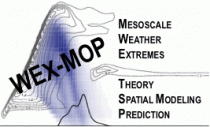Mesoscale weather extremes: Theory, spatial modelling and prediction (WEX-MOP)
Mesoscale weather extremes: Theory, spatial modelling and prediction (WEX-MOP)
High-impact extreme weather events,  such as heavy rainfall and/or strong winds are very often associated with intensive atmospheric fronts with strong gradients or deep moist convection. These events are governed by mesoscale atmospheric dynamics, operating on horizontal scales ranging from a few to several hundred kilometers. In the WEX-MOP project, a team of atmospheric and mathematical scientists will join forces to work on theory, spatial statistical and dynamical modeling, and prediction for mesoscale weather extremes, to advance prognoses of severe weather events. The project will release developments towards a next-generation comprehensive mesoscale prediction system for extreme weather.
such as heavy rainfall and/or strong winds are very often associated with intensive atmospheric fronts with strong gradients or deep moist convection. These events are governed by mesoscale atmospheric dynamics, operating on horizontal scales ranging from a few to several hundred kilometers. In the WEX-MOP project, a team of atmospheric and mathematical scientists will join forces to work on theory, spatial statistical and dynamical modeling, and prediction for mesoscale weather extremes, to advance prognoses of severe weather events. The project will release developments towards a next-generation comprehensive mesoscale prediction system for extreme weather.
WEX-MOP is a collaboration project between University of Bonn, University of Mannheim, the Heidelberg Institute for Theoretical Studies and NR. The project is funded by VolkswagenStiftung and is currently in its second phase. NR contributes to two sub-projects of WEX-MOP:
-
Physically coherent probabilistic weather forecasts
Statistical postprocessing of weather forecast ensembles is important to correct model biases and dispersion errors in the ensemble. While several postprocessing methods exist, they commonly apply to a single weather variable at a single location and a single look-ahead time only, and they are confined to the model grid. A key challenge then is the extension to the joint treatment of several variables at groups of points and for time intervals. This will be addressed here through the development of the ensemble copula coupling (ECC) method, which provides an elegant way of restoring physical coherence across weather variables, space and time in postprocessed, gridded ensemble forecasts. -
Forecast verification, extreme events, and spatio and spatio-temporal structure
While the restoration of physical coherence in probabilistic forecasts is particularly important when extreme weather is impending, there is a notable lack of theoretically justifiable methods for the evaluation of probabilistic forecasts of rare and extreme events, as well as of spatial and spatio-temporal fields. To assess the use of these methods in next-generation mesoscale prediction systems for extreme weather, new tools for forecast verification are required, that are tailored to probabilistic forecasts of extreme events, as well as spatial and spatio-temporal weather fields.
Publications
- Lerch, S. and Thorarinsdottir, T. L. (2013). Comparing nonhomogeneous regression models for probabilistic wind speed forecasting. Tellus A, 65, 21206.
- Schefzik, R., Thorarinsdottir, T. L. and Gneiting, T. (2013). Uncertainty quantification in complex simulation models using ensemble copula coupling. Stat Sci, 28, 616-640.
- Friederichs, P. and T. Thorarinsdottir (2012): Forecast verification scores for extreme value distributions with an application to peak wind prediction. Environmetrics, 23(7), 579-594.
- Schuhen, N., Thorarinsdottir, T. L. and Gneiting, T. (2012). Ensemble model output statistics for wind vectors. Mon Weather Rev, 140, 3204-3219.

Project period
Financing
VolkswagenStiftung
Partners
University of Bonn
University of Mannheim
HITS, Heidelberg


 How to get to NR
How to get to NR Share on social media
Share on social media Privacy policy
Privacy policy